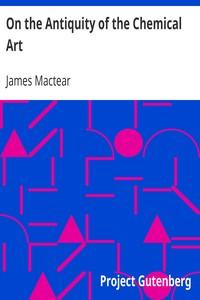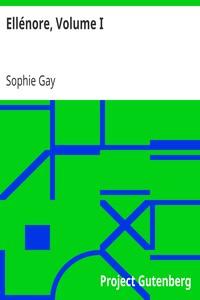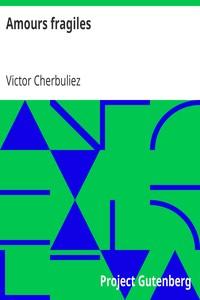|
|
Read this ebook for free! No credit card needed, absolutely nothing to pay.Words: 34063 in 10 pages
This is an ebook sharing website. You can read the uploaded ebooks for free here. No credit cards needed, nothing to pay. If you want to own a digital copy of the ebook, or want to read offline with your favorite ebook-reader, then you can choose to buy and download the ebook.

: Scientific American Supplement No. 717 September 28 1889 by Various - Science Periodicals Scientific American@FreeBooksTue 06 Jun, 2023 atus by reducing their dimensions is at once prevented by the relatively great importance of the vagaries of the silk suspension. The result, then, is this. The smallness, the length of period, and therefore delicacy, of the instruments at the physicist's disposal have until lately been simply limited by the behavior of silk. A more perfect suspension means still more perfect instruments, and therefore advance in knowledge. It was in this way that some improvements that I was making in an instrument for measuring radiant heat came to a deadlock about two years ago. I would not use silk, and I could not find anything else that would do. Spun glass, even, was far too coarse for my purpose, it was a thousand times too stiff. There is a material invented by Wollaston long ago, which, however, I did not try because it is so easily broken. It is platinum wire which has been drawn in silver, and finally separated by the action of nitric acid. A specimen about the size of a single line of silk is now on the screen, showing the silver coating at one end . As nothing that I knew of could be obtained that would be of use to me, I was driven to the necessity of trying by experiment to find some new material. The result of these experiments was the development of a process of almost ridiculous simplicity which it may be of interest for me to show. The apparatus consists of a small crossbow, and an arrow made of straw with a needle point. To the tail of the arrow is attached a fine rod of quartz which has been melted and drawn out in the oxyhydrogen jet. I have a piece of the same material in my hand, and now after melting their ends and joining them together, an operation which produces a beautiful and dazzling light, all I have to do is to liberate the string of the bow by pulling the trigger with one foot, and then if all is well a fiber will have been drawn by the arrow, the existence of which can be made evident by fastening to it a piece of stamp paper. In this way threads can be produced of great length, of almost any degree of fineness, of extraordinary uniformity, and of enormous strength. I do not believe, if any experimentalist had been promised by a good fairy that he might have anything he desired, that he would have ventured to ask for any one thing with so many valuable properties as these fibers possess. I hope in the course of this evening to show that I am not exaggerating their merits. In the first place, let me say something about the degree of fineness to which they can be drawn. There is now projected upon the screen a quartz fiber one five-thousandth of an inch in diameter . This is one which I had in constant use in an instrument loaded with about 30 grains. It has a section only one-sixth of that of a single line of silk, and it is just as strong. Not being organic, it is in no way affected by changes of moisture and temperature, and so it is free from the vagaries of silk which give so much trouble. The piece used in the instrument was about 16 inches long. Had it been necessary to employ spun glass, which hitherto was the finest torsion material, then, instead of 16 inches, I should have required a piece 1,000 feet long, and an instrument as high as the Eiffel tower to put it in. There is no difficulty in obtaining pieces as fine as this yards long if required, or in spinning it very much finer. There is upon the screen a single line made by the small garden spider, and the size of this is perfectly evident . You now see a quartz fiber far finer than this, or, rather, you see a diffraction phenomenon, for no true image is formed at all; but even this is a conspicuous object in comparison with the tapering ends, which it is absolutely impossible to trace in a microscope. The next two photographs, taken by Mr. Nelson, whose skill and resources are so famous, represent the extreme end of a tail of quartz, and, though the scale is a great deal larger than that used in the other photographs, the end will be visible only to a few. Mr. Nelson has photographed here what it is absolutely impossible to see. What the size of these ends may be, I have no means of telling. Dr. Royston Piggott has estimated some of them at less than one-millionth of an inch, but, whatever they are, they supply for the first time objects of extreme smallness the form of which is certainly known, and, therefore, I cannot help looking upon them as more satisfactory tests for the microscope than diatoms and other things of the real shape of which we know nothing whatever. Since figures as large as a million cannot be realized properly, it may be worth while to give an illustration of what is meant by a fiber one-millionth of an inch in diameter. A piece of quartz an inch long and an inch in diameter would, if drawn out to this degree of fineness, be sufficient to go all the way round the world 658 times; or a grain of sand just visible--that is, one-hundredth of an inch long and one hundredth of an inch in diameter--would make one thousand miles of such thread. Further, the pressure inside such a thread due to a surface tension equal to that of water would be 60 atmospheres. Going back to such threads as can be used in instruments, I have made use of fibers one ten-thousandth of an inch in diameter, and in these the torsion is 10,000 times less than that of spun glass. Free books android app tbrJar TBR JAR Read Free books online gutenberg More posts by @FreeBooks
: Gustavus Vasa and other poems by Walker William Sidney - Poetry; Gustav I Vasa King of Sweden 1496-1560 Poetry@FreeBooksTue 06 Jun, 2023

: On the Antiquity of the Chemical Art by Mactear James - Chemistry History Chemistry@FreeBooksTue 06 Jun, 2023
|
Terms of Use Stock Market News! © gutenberg.org.in2025 All Rights reserved.






